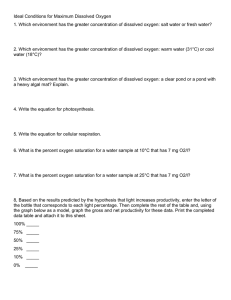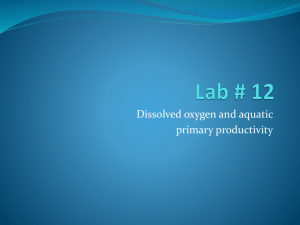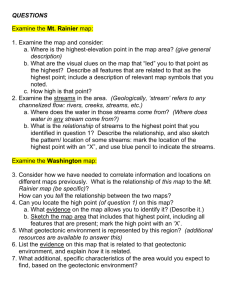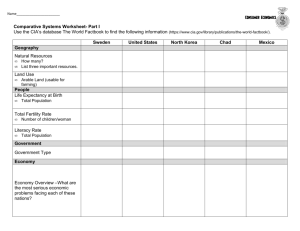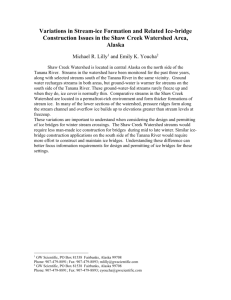DISSOLVED OXYGEN CONTENT: PAVED VERSUS UNPAVED SURFACES IN DOG RIVER WATERSHED
advertisement
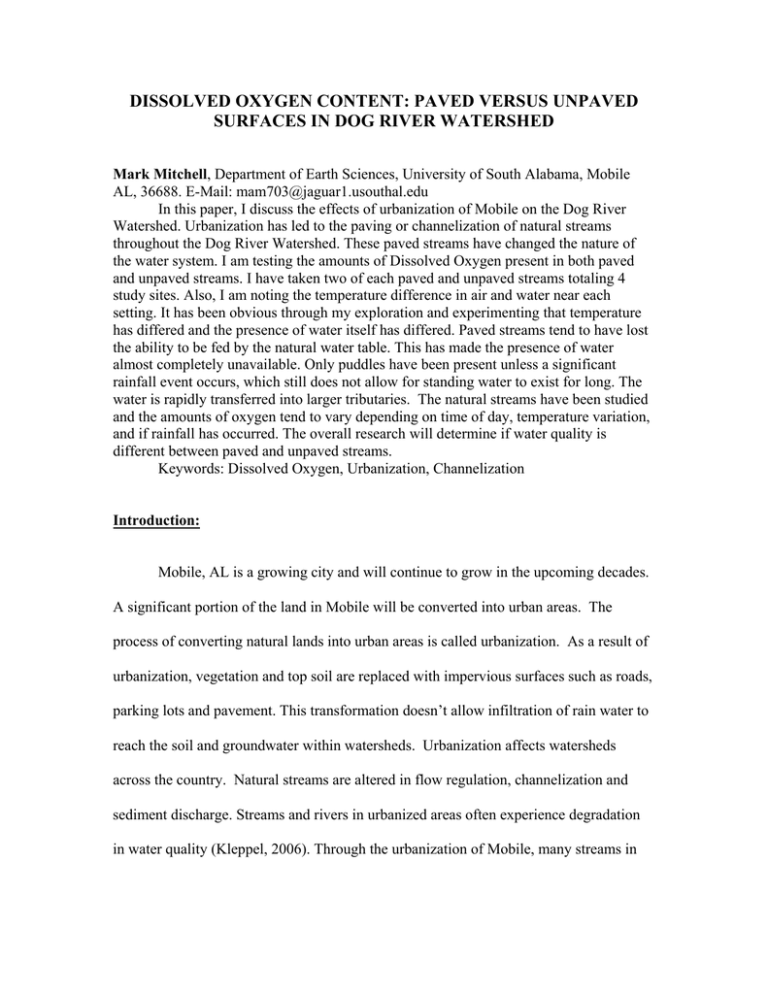
DISSOLVED OXYGEN CONTENT: PAVED VERSUS UNPAVED SURFACES IN DOG RIVER WATERSHED Mark Mitchell, Department of Earth Sciences, University of South Alabama, Mobile AL, 36688. E-Mail: mam703@jaguar1.usouthal.edu In this paper, I discuss the effects of urbanization of Mobile on the Dog River Watershed. Urbanization has led to the paving or channelization of natural streams throughout the Dog River Watershed. These paved streams have changed the nature of the water system. I am testing the amounts of Dissolved Oxygen present in both paved and unpaved streams. I have taken two of each paved and unpaved streams totaling 4 study sites. Also, I am noting the temperature difference in air and water near each setting. It has been obvious through my exploration and experimenting that temperature has differed and the presence of water itself has differed. Paved streams tend to have lost the ability to be fed by the natural water table. This has made the presence of water almost completely unavailable. Only puddles have been present unless a significant rainfall event occurs, which still does not allow for standing water to exist for long. The water is rapidly transferred into larger tributaries. The natural streams have been studied and the amounts of oxygen tend to vary depending on time of day, temperature variation, and if rainfall has occurred. The overall research will determine if water quality is different between paved and unpaved streams. Keywords: Dissolved Oxygen, Urbanization, Channelization Introduction: Mobile, AL is a growing city and will continue to grow in the upcoming decades. A significant portion of the land in Mobile will be converted into urban areas. The process of converting natural lands into urban areas is called urbanization. As a result of urbanization, vegetation and top soil are replaced with impervious surfaces such as roads, parking lots and pavement. This transformation doesn’t allow infiltration of rain water to reach the soil and groundwater within watersheds. Urbanization affects watersheds across the country. Natural streams are altered in flow regulation, channelization and sediment discharge. Streams and rivers in urbanized areas often experience degradation in water quality (Kleppel, 2006). Through the urbanization of Mobile, many streams in the Dog River Watershed have been channeled and paved. The results have increased the flow of water from the tributaries into Dog River. Urbanization may also affect the water quality within a watershed. Water quality is determined through many different tests. Variables that may affect water quality are temperature, pH levels, oxygen content, and salinity. Temperature variability is one of the most important variables in determining water quality. The temperatures of water in urbanized areas also tend to increase as well (LeBlanc, 1997). If temperatures within a water system are increased, it will endanger some of the habitants in the water system, such as fish and some microorganisms. Elements that affect the temperature of the water are sediments, groundwater discharge, and channel depth (Wolanski, 2007). All elements that are altered through the urbanization process as well. Also, air temperature through conduction, may also affect the temperature of the water. Water temperature also has an effect on the oxygen content within the water. Dissolved oxygen is also important in determining water quality. The measurement of dissolved oxygen content within a water system can help document changes in water systems from natural phenomena or human interaction within the environment. Dissolved oxygen is essential for survival and growth of aquatic organisms. Oxygen enters water through many different processes. For example, algae and plants release oxygen through photosynthesis. Also, water obtains oxygen through direct contact with the atmosphere in a process called diffusion. Temperature also has an effect on the amount of oxygen content in the water. Through urbanization Dog River Watershed has had some alterations to its natural environment. For example, the channeling and paving of streams near the downtown 2 Mobile area may have affected the temperature and the amount of dissolved oxygen. This paper will make a comparison of temperature and the amounts of dissolved oxygen in paved streams and natural streams within the Dog River Watershed. Research Question: Dissolved oxygen and temperature are a major component to demonstrate the water quality within a water body. Has urbanization of Mobile, and man-made paved surfaces within the Dog River Watershed, caused a decrease in the amount of dissolved oxygen and a fluctuation in water temperature? Study Area: The study area was located in Mobile, AL. The Dog River Watershed (Figure 1) is located in Mobile County. I then examined suitable areas within the watershed to conduct the research. I chose two areas for each paved and natural surfaces within the watershed to conduct the study. These areas are zoomed in to on Figure 1 Figure 2, the green stars are indicative of natural stream study sites and the red stars indicate paved stream study sites. The natural study sites are Second Creek at Cottage Hill, and at Schillinger just south of 3 Hitt Rd. The paved study areas are Spencer Branch behind Knollwood Apartments on Knollwood Blvd. and Eslava Creek at McGregor. Figure 2 . Methods: After careful consideration of choosing my study area, the methods used come into action. In order to determine the oxygen content, I completed an oxygen test according to Alabama Water Watch Association Protocol. I first took the air temperature of each study area. When taking the air temperature, I made sure that the thermometer was exposed to the air for at least two minutes before taking the reading in ºC. Then, I took the temperature of the water. Also, making sure the thermometer was submerged in the water for at least two minutes before making a reading in ºC. 4 After temperature of both the air and water were recorded, I then gathered my sample. The first step is to make sure that the sample bottles are rinsed 2-3 times before collecting a sample. I always took two samples at a time to ensure accuracy. Next, I tightly fasten the top of the bottle and submerge the bottle 9-12 inches below the surface. Then, while the bottle was submerged, I unscrewed the top and allowed water to enter the sample bottle. Once the bottle was full, I recapped and pulled the sample bottle out of the water, making sure there were no air bubbles in the sample. Now I began the chemical testing process. I unscrewed the cap and first added 8 drops of Manganous Sulfate to the bottle, then 8 drops of Alkaline Potassium Iodide Azide. Then, recapped the bottle and inverted it at least ten times. At this point a tan, cloudy mixture would form form. I allowed the mixture to settle below the shoulder of the bottle before I added 8 drops of Sulfuric Acid. Next, I recapped the bottle and inverted at least eight times and wait for the sample to clear out and turn a golden color. This process fixes the sample, now it’s ready for testing. Now, I poured 20 mL of the fixed sample into a titration tube. Then I added 8 drops of starch into the bottle. The sample turned into a dark blue or black. Next, I filled a Tritrator with Sodium Thiosulfate. I then measured the amount of Sodium Thiosulfate added to the dark blue or black sample until it turned clear. This gives the amount of Dissolved Oxygen in ppm (parts per million). I completed this process for every sample taken and recorded the DO ppm. I collected samples every other day between 10 a.m. and 2 p.m. for a four week trial in both paved and unpaved streams within the Dog River Watershed. Then I graphed and 5 began to determine if there was any negative or positive relationship in dissolved oxygen content between paved and unpaved streams. Results: I can examine the two natural streams dissolved oxygen content, but not the same for the paved. The paved areas hardly had enough water to be sampled so a complete data set had not been collected. I didn’t throw out this data but it is insufficient in comparing to the natural streams. The first study site of Second Creek, at Cottage Hill Rd., was located near a bridge crossing. The graph (Figure 3) indicates that the temperature was 2 to 3 degrees cooler than my second study site. I thought I would have had a higher oxygen content due to a drop of causing much more mixing with air. The oxygen content tends to increase with a decrease in temperature. The oxygen amounts remain habitable for aquatic life. Second Creek: Site 1 Atemp F Wtemp F 12 80 11 70 10 60 9 50 8 40 7 30 6 10 5 0 4 24 /2 00 9 3/ 26 /2 00 9 3/ 31 /2 00 9 4/ 2/ 20 09 4/ 3/ 20 09 4/ 5/ 20 09 4/ 7/ 20 09 4/ 9/ 20 09 4/ 12 /2 00 9 4/ 14 /2 00 9 4/ 16 /2 00 9 4/ 21 /2 00 9 4/ 23 /2 00 9 20 Date Visited Figure 3 6 Dissolved Oxygen (ppm) 90 3/ Temerature (F) DO (ppm) The second site of Second Creek just south of Hitt Rd. on Schillinger was located near a construction site. This water was stagnant and had a reddish-brown tint to it. Also, there was a layer of filmy water on top, I was a bit nervous to stick my hands into this water. To my surprise, the results (Figure 4) were similar to the first study site just temperatures 2 to 3 degrees warmer in air and about 2 degrees warmer in water. The oxygen amounts were a little inconsistent to temperature though. Second Creek: Site 2 Atemp F Wtemp F DO (ppm) 90 12 Temperature (F) 10 70 9 8 60 7 50 6 40 Dissolved Oxygen (ppm) 11 80 5 4 3/ 24 /2 00 9 3/ 26 /2 00 9 3/ 31 /2 00 9 4/ 2/ 20 09 4/ 3/ 20 09 4/ 5/ 20 09 4/ 7/ 20 09 4/ 9/ 20 09 4/ 12 /2 00 9 4/ 14 /2 00 9 4/ 16 /2 00 9 4/ 21 /2 00 9 4/ 23 /2 00 9 30 Date Visited Figure 4 Conclusion/ Discussion: I can conclude that paved streams in my study area are hard to compare to natural streams. The elevation of the study area sends run-off water down the paved streams into lower lying elevations quickly. This doesn’t allow for standing water to exist in my study areas very long. But, this rush of water can cause some flash flooding in lower lying areas downstream. The paved streams are speeding up the travel of the water. If this study was done over again, I would do some things different. For example, I would have 7 chosen my paved areas to be further into downtown Mobile. I would do that so slope or elevation would not allow the water to be removed from the paved streams so quickly. I cannot conclude that paved waterways are actually affecting the water quality or the amount of dissolved oxygen content of the area. I can conclude that the pavement is cutting off access into the ground water feed that streams need in order to have water remain in them. Also, that the paved streams allow for water to travel more rapidly downstream that may cause flooding into low-lying, developed areas downstream. Bibliography Bradford, Andrea and Gregory E. Norton 2008, Comparison of two stream temperature models and evaluation of potential management alternatives for the Speed River, Southern Ontario, Academic Search Premiere . Cleveland, April J. Science Junction - Water What IF’s. 1998. http://www.ncsu.edu/sciencejunction.depot/experiments/water/lessons/do (Accessed on February 27, 2009) Kleppel, G.S. and M. Richard DeVoe, eds. 2006. Changing Land Use Patterns in the Coastal Zone: Managing Environmental Quality in Rapidly Developing Regions. New York, NY Springer Press. Leopold, Luna B. 1968 Hydrology for Urban Planning – A Guidebook on the Hydrologic Effects on Urban Land Use. USGS, Washington, D.C. R.T. LeBlanc, R.D. Brown and J.E. FitzGibbon 1997, Modeling the effects of land use change on the water temperature in unregulated urban streams, Journal of Environmental Management 49 , pp. 445–469. Wolanski, Eric. 2007. Estuarine Ecohydrology. Oxford, UK: Elsevier. 8
